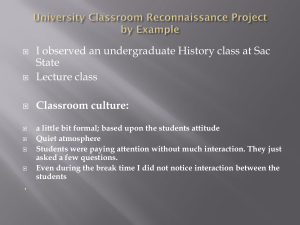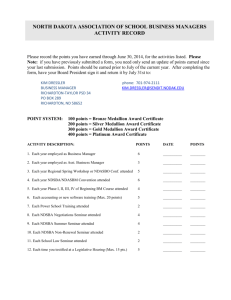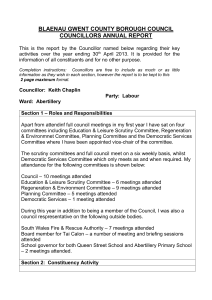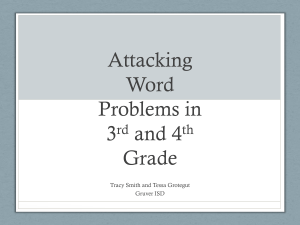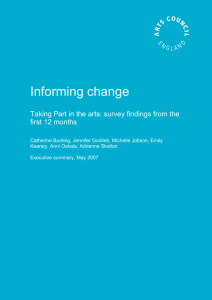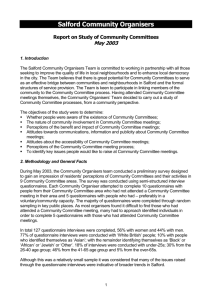sol_prob
advertisement
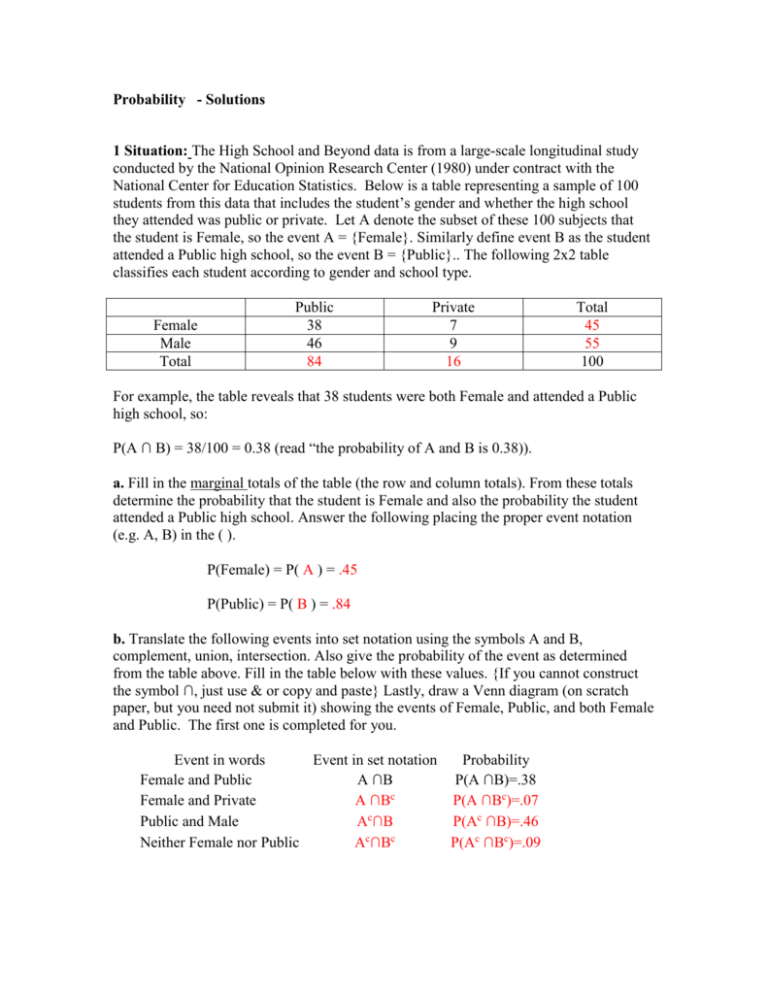
Probability - Solutions
1 Situation: The High School and Beyond data is from a large-scale longitudinal study
conducted by the National Opinion Research Center (1980) under contract with the
National Center for Education Statistics. Below is a table representing a sample of 100
students from this data that includes the student’s gender and whether the high school
they attended was public or private. Let A denote the subset of these 100 subjects that
the student is Female, so the event A = {Female}. Similarly define event B as the student
attended a Public high school, so the event B = {Public}.. The following 2x2 table
classifies each student according to gender and school type.
Female
Male
Total
Public
38
46
84
Private
7
9
16
Total
45
55
100
For example, the table reveals that 38 students were both Female and attended a Public
high school, so:
P(A ∩ B) = 38/100 = 0.38 (read “the probability of A and B is 0.38)).
a. Fill in the marginal totals of the table (the row and column totals). From these totals
determine the probability that the student is Female and also the probability the student
attended a Public high school. Answer the following placing the proper event notation
(e.g. A, B) in the ( ).
P(Female) = P( A ) = .45
P(Public) = P( B ) = .84
b. Translate the following events into set notation using the symbols A and B,
complement, union, intersection. Also give the probability of the event as determined
from the table above. Fill in the table below with these values. {If you cannot construct
the symbol ∩, just use & or copy and paste} Lastly, draw a Venn diagram (on scratch
paper, but you need not submit it) showing the events of Female, Public, and both Female
and Public. The first one is completed for you.
Event in words
Event in set notation
Probability
Female and Public
A ∩B
P(A ∩B)=.38
c
Female and Private
A ∩B
P(A ∩Bc)=.07
Public and Male
Ac∩B
P(Ac ∩B)=.46
Neither Female nor Public
Ac∩Bc
P(Ac ∩Bc)=.09
c. Determine the probability that the student is Male. Do the same for student attending a
Private high school. Use proper event notation remember that A is Female and B is
Public.
P(Male) = P( Ac ) = 0.55
P(Public) = P( Bc ) = 0.16
.
d. If you had not been given the table, but instead had merely been told that P(A)=.45 and
P(B)=.84, would you have been able to calculate P(Ac) and P(Bc)? Explain how.
Yes we could compute the probability of the complement of an event using the
probability of the event by subtracting the value of the probability of the event from one:
P(Male) = P(Ac) = 1- P(A)=1-.45 = .55
P(Private) =P(Bc) =1- P(B) = 1-.84= .16
e. Calculate the probability that at least either the student is Female or the student
attended a Public high school.
Using the addition rule: P(A ∪ B) = P(A) + P(B) – P(A ∩ B)=.45+.84-.38=.91
f. Another way to calculate P(A ∪ B) in part e is to use the complement of the event.
First, in words what is the complement to the event described in e and then find this
probability using the complement. Does this match your answer in e?
The complement of the event {Female or Publick} is the event {neither Female
nor Public}, or in other words {Male and Private}. In symbols we can describe
this event as (A ∪ B)c which equals Ac ∩ Bc. Thus P(A ∪ B)= 1 - P(Ac ∩ Bc) =
1 - 0.09 = 0.91
g. If you had not been given the table but instead had merely been told P(A)=.45 and
P(B)=.84 and were asked to calculate P(A ∪ B), you might first consider P(A)+P(B).
Calculate this sum and compare the result to your answer for e. Are they the same? Is
this even a legitimate answer?
P(A)+P(B)=1.29 This value does not equal the value of P(A ∪ B) computed above.
It is also not a legitimate answer since the probability be a number in the interval
[0,1].
h. Given the knowledge that the student is Female, what is the conditional probability
that the student attended a Public high school? [Hint: Restrict your consideration to
Females, and ask yourself what fraction of those female students attended a Public
high school?]
This is asking to find P(B|A) = P(A ∩ B)/P(A) = 0.38/0.45 = 0.844
i. How does this conditional probability of the student attending a Public high school
given that the student is Female compare with the unconditional probability of the
student attending a Public high school? Does the knowledge that the student is
Female make it more or less likely (or neither) that the student attended a Public high
school?
The conditional probability (0.844) is approximately equal to than the
unconditional probability (0.84) that the student attended a Public high school. Since
these are so close in probability, knowing that the student is Female does not improve
the probability that the student attended a Public high school. [Note: later in the
course we will discuss a procedure that tests whether a relationship exists between
two categorical variables such as the ones used in this activity. This test will allow us
to statistically show whether 0.844 is statistically different from 0.84, thus removing
the personal judgment involved in saying “are these close enough?”]
2 Graduate School Admissions Suppose that you apply to two graduate schools A and
B, and that you believe your probability of acceptance by A to be 0.7, your probability of
acceptance by B to be 0.6, and your probability of acceptance by both to be 0.5.
a. Are the events {acceptance by A} and {acceptance by B} independent? Explain.
{Hint: look at the definition for independence from the lecture notes or in the Probability
Rules table on page 223.}
If two events are independent the probability that both events occur equals the product of
their individual probabilities. That is, P(A ∩ B) = P(A)*P(B). In this case, P(A)*P(B) =
0.7*0.6 = 0.30, and P(A ∩ B) = 0.5. Since these are not equal, then A and B are not
independent.
b. Determine the conditional probability of acceptance by B given acceptance by A? How
does it compare to the (unconditional) probability of acceptance by B?
P(B|A) = P(A ∩ B)/P(A) = 0.5/0.7 = 0.71
c. What is the probability that you are accepted by at least one of the two schools?
P(A ∪ B) = P(A) + P(B) - P(A ∩ B) = 0.7 + 0.6 – 0.5 = 0.8
3 Just for fun! Back in the Seventies there was a game show called “Let’s Make a
Deal”. The rules were simple: a contestant was selected from the crowd and offered the
chance to open one of 3 doors. Behind one door was a prize (e.g. money, new car), while
behind the other two doors were gag prizes (e.g. a donkey, barrel of popcorn). After
making their choice of door the game show host would open one of the non-selected
doors which was always one that did not contain the prize. The contestant was then
asked if he or she would like to switch from their first choice to the remaining unopened
door or stay with their original choice. If you were the contestant, what choice would
you make? That is, given that you now have two doors unopened, one with a prize
behind it and the other without, which gives you a better chance of winning: switching
doors or staying with your original choice? After you have thought about this, please
visit the following website and try it out! {You may have to click the refresh button after opening the page}
http://www.stat.sc.edu/~west/javahtml/LetsMakeaDeal.html
You should switch! The website provides a nice explanation as to why.


